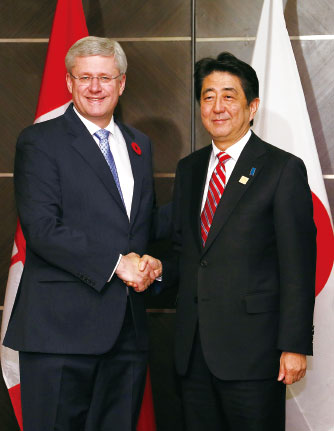Diplomatic Bluebook 2015
Chapter 2
Japan’s Foreign Policy that Takes a Panoramic Perspective of the World Map
2.Canada
(1) Situation of Canada
Prime Minister Harper had stably managed his government; however, approval ratings for the ruling Conservative Party declined because of scandals over illicit receipt of allowances involving several senators in 2013, among others. This situation continued in 2014, in which approval ratings became almost tied with those of the opposition Liberal Party.
A case of shootings in Ottawa on October 22, 2014, that claimed a life of a soldier of the Canadian Forces, shocked Canada as well as overseas.
In the area of diplomacy, Canada promotes diplomatic policies placing emphasis on fundamental values such as freedom, human rights, democracy, and rule of law as well as diplomatic policies leading to economic revitalization and the promotion of employment. Furthermore, Canada has chaired the Arctic Council for a two-year term since May 2013.
In the area of economy, Canada concluded the Comprehensive Economic and Trade Agreement (CETA) negotiations with the EU in September, and signed the FTA with the Republic of Korea (ROK), which constitutes Canada’s first FTA in the Asia Pacific region. In October, the FTA with Honduras and Foreign Investment Promotion and Protection Agreement with China came into effect. Furthermore, through the negotiations concerning the TPP, the Japan-Canada EPA, and the Canada-India FTA, Canada has made continuous efforts to expand trade with Asia as well as the American region.
With regard to the domestic economy, it shows signs of a wide-ranging recovery, and robust exports have had a positive effect on private-sector capital investment and the increase of employment.
(2) Japan-Canada Relations
In March 2014, Prime Minister Abe held a Japan-Canada summit meeting with Prime Minister Harper on the occasion of the Nuclear Security Summit held in The Hague in the Netherlands, and confirmed the steady implementation of agreed commitments made at the summit meeting in September 2013, such as the holding of the second Political, Peace and Security Subcabinet “2+2” Dialogue and flights to and from Haneda Airport by Air Canada. In addition, Prime Minister Abe expressed his expectations for the early realization of stable imports of reasonably priced LNG to Japan, and both leaders exchanged views on issues such as TPP negotiations and Japan-Canada EPA negotiations. Both leaders also held a summit meeting in November on the occasion of the APEC Summit Meeting held in Beijing and exchanged views on such topics as bilateral relations and regional situations.
Furthermore, Foreign Minister Kishida held a foreign ministers’ meeting with Foreign Minister Baird, who visited Japan in July, 2014, and exchanged views on such issues as bilateral relations, regional situations, TPP, and Japan-Canada EPA negotiations.
In March, 2014, the second Political, Peace and Security Subcabinet “2+2” Dialogue was held in Ottawa. In June, the 12th Japan-Canada Symposium on Peace and Security Cooperation, which is a dialogue between experts of the two countries with the attendance of both governments, as well as the 8th Japan-Canada Politico-Military (PM) Dialogue were held in Tokyo.
In the area of economy, the 26th Japan-Canada Joint Economic Committee was held in January, and both countries exchanged their views on broad topics including Japan-Canada economic relationship, the two countries’ trade policies, cooperation on resources and energy, as well as global economic issues. Furthermore, the 5th EPA negotiations meeting, the 6th EPA negotiations meeting and the 7th EPA negotiations meeting were held in March, July, and November respectively, in which significant discussions were conducted in the fields of services trade, investment, intellectual property, energy, minerals, and food. Canada’s natural gas production is the fifth largest in the world, and a project of LNG export to Asia, in which several Japanese companies are involved, is in progress in the west although there has been no export record to Japan so far.
In addition, between Japan and Canada, a youth exchange project titled “KAKEHASHI Project —The Bridge for Tomorrow—” has been implemented, in which 50 Canadian youth visited Japan while Japan dispatched 175 youth to Canada in 2014, bringing the total number of visiting youths to 200 and dispatched youths to 200 by March 2014.
As described above, efforts towards further strengthen bilateral relations in a variety of areas including politics, security, economy, and people-to-people exchanges are currently being made.
 Prime Minister Harper and Prime Minister Abe at the Japan-Canada summit meeting (November 9, Beijing, China; Source: Cabinet Public Relations Office)
Prime Minister Harper and Prime Minister Abe at the Japan-Canada summit meeting (November 9, Beijing, China; Source: Cabinet Public Relations Office)
